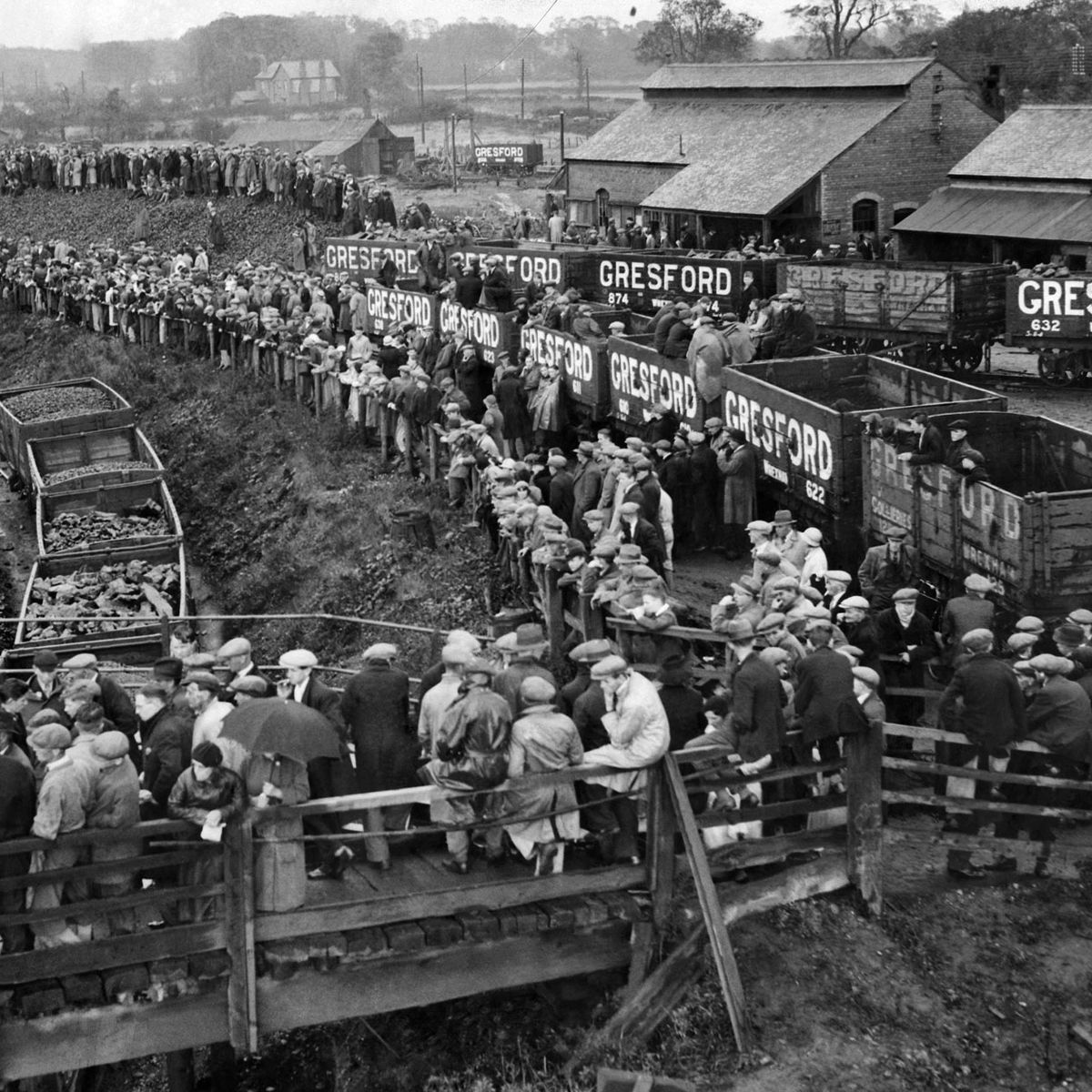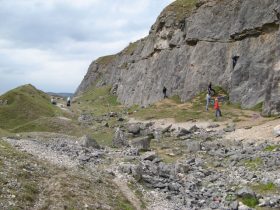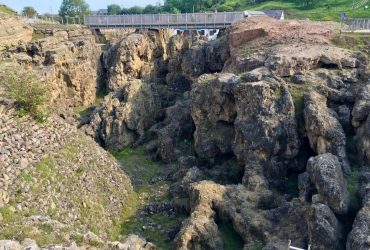Remembering the Gresford Disaster

On this date, September 22nd in 1934, just a short distance from where I sit writing this article 266 men and boys where killed at Gresford Colliery. An explosion and underground fire devastated the local area, where barely a local family was left unaffected by the event.
The Cause still reads “Exact cause not determined” but in a day where profits and personal pride of the establishment seemed more important than human life, it is now widely accepted that the evidence all pointed to failures in safety procedures and poor mine management.
To pour extra salt into the wounds a decision was made to permanently seal the colliery’s damaged areas, meaning that only eleven bodies of those who died were ever recovered.
The explosion happened at 2:08am ripping through the Dennis section, one of three coal seams being worked at Gresford at that time. Dennis section held a 2.1metre seam that produced softer industrial coal.
In Dennis the night overman, Fred Davies, who was on duty at the bottom of the main shaft, heard a crashing sound and was enveloped in a cloud of dust for around 30 seconds. When it cleared he telephoned the surface and told William Bonsall, the manager: “something has happened down the Dennis. I think it has fired.” Bonsall immediately went into the mine to try to establish what had occurred. At approximately 3.30am the afternoon shift overman, Benjamin Edwards, reported that parts of the Dennis main road were on fire beyond a junction, known as the Clutch, where the haulage motors were located, and that a large number of miners were trapped beyond the blaze. Meanwhile, the shift that was working the Slant was ordered to the pit bottom and told to get out of the mine.
Only six men had escaped from the Dennis section, all of whom were working in 29’s district: Robert (Ted) Andrews, Cyril Challoner, Thomas Fisher, David Jones (the district’s night shift deputy), Albert (Bert) Samuels, and Jack Samuels. Some of the group were sitting taking a mid-shift break about 300 yards (270 m) north of the Clutch when the initial explosion happened. Jack Samuels, in his testimony at the inquest, described hearing a “violent thud […] followed at once by dust” while at the face and commenting “that’s the bloody bottom gone”.
By the “bottom”, Samuels clarified that he meant 14’s district, which lay below them. A colleague advised them to leave the district via the “wind road” which was the 29’s air return drift. Samuels told a further 30 men working in the 29’s district to follow. But as the six-man lead group went ahead attempting to fan the air to mitigate the effects of the deadly afterdamp, they soon realised the other miners had not followed them. Jack Samuels described how Jones repeatedly fell back, commenting he was “done”, but Samuels told him to “stick it” and shouldered the deputy up a ladder; Samuels was commended at the inquest for his bravery and leadership of the group. After a long and difficult escape up 1:3 gradients, several ladders, and past rockfalls, the six miners eventually rejoined the Dennis main road and met Andrew Williams, the under-manager, who along with Bonsall had immediately descended the Dennis main shaft on being notified of the explosion. Williams took David Jones and went on towards the Clutch, while the remaining five went to the pit bottom and safety.
Beyond the Clutch, Williams found three falls in the main haulage road. Once he got past them he discovered a fire had started about 20 yards before the main entrance to 29’s district, blocking escape from the districts further inbye, and immediately sent back for men and materials to fight it. The evidence of Williams, Bonsall and Ben Edwards, who all saw the fire at this critical point, differed on how large it was: Bonsall thought they could not get close enough to it to fight it, but Edwards, who was able to view the burning spot directly, said that it did “not seem much of a fire”, and the final report of the inquest was inconclusive as to whether the fire could have been put out at this stage if better equipment had been to hand. Williams and the overman Fred Davies made an initial attempt to get up to the fire using breathing apparatus, but were driven back by fumes.
Shortly before dawn, volunteers with pit ponies began entering the pit to tackle the fire and clear debris. The trained mine rescue teams around the area were alerted but delays and management failures meant there were delays in response.
In the interim many volunteers from the area’s mines were sent below to assist: a manager from another colliery, sent down at about 4:30 am, described his attempts to extinguish the fires. Six dead miners, all men who had been working near the Clutch, were soon brought to the surface. By 5:00 am the Gresford rescue team was already in the pit and some of the teams from the neighbouring Llay Main Colliery were at the surface, though they grew increasingly frustrated while waiting to be called down.
At 8:40 am, the 18-man Llay team finally received a call down the pit and went in accompanied by a Gresford miner who was to show them the way. In a somewhat disorganised fashion John Charles Williams and his two rescue men making up the No. 1 Llay team, along with a Gresford rescue man W. Hughes, were instructed by the Gresford staff then below ground to check the mile-long return airway of the 20’s district. Bonsall later stated that his intent had only been that the team establish the atmosphere in the return: he claimed that his order had been “not to go in until they got definite instructions from me, because what I had in my mind was that it would be charged with carbon monoxide, and I did not want them to go through that because there would not be the slightest chance of getting men back through it.” The instruction was, however, misinterpreted by a deputy as meaning that the team should physically enter the return; accordingly the rescue team entered the airway using breathing apparatus, despite the fact that their canary died instantly. Williams, the team’s leader, ordered them back when after several hundred yards after the airway ahead narrowed to 3 feet (0.91 m) by 3 feet (0.91 m) and less. Two of the team then in Williams’ words “seemed to get alarmed” and collapsed, possibly after removing their nose clips; Williams then tried dragging a third team member for over 40 yards (37 m) towards safety before being overcome himself by poisonous gases. Williams would be the only survivor; he was said by his family to be the man who later wrote the anonymous broadside ballad “The Gresford Disaster”, which was highly critical of the mine’s management.
Despite the fact that the carbon monoxide levels in the 20’s return suggested that no-one further inbye could be left alive, rescue efforts became focused on trying to fight the fire at 29’s Turn, using sand, stone dust, and extinguishers. The miners trapped in the most northerly districts, the 20’s and 61’s, would have been more than 1 mile (1.6 km) on the other side of the fire, and rockfalls at the entrance to the 29’s soon made it clear there was little chance of escape for the men trapped in the affected districts. As the falls were levelled, the fire become more severe: Parry Davies, captain of the Llay No. 2 rescue team, described the whole end of the level as “one mass of flame, the coal sides of the roadway, burning in one white mass, and the more stones we moved to one side, the more air we put on to the flames […] It was most peculiar to see the flames from that fire, all the colours of the rainbow, a sight which I will never forget.”
By early Saturday morning large crowds of concerned relatives and off-duty miners had gathered silently at the pit head awaiting news. Hopes were raised in the evening when rumours began circulating that the fire in the Dennis main road was being brought under control; families waiting at the surface were told rescue teams would soon be able to reach the miners in the 29’s, the nearest district beyond the Clutch.
However, by Sunday evening it became clear that conditions in the pit had become extremely hazardous. Fire took hold in 29’s haulage road as well as 142’s Deep, and the rescue teams were withdrawn as further explosions took place behind a heavy fall on the far side of the fire. Relatives were told the shafts into the Dennis section would be capped because no one could have survived and it was far too dangerous to try to recover any further bodies. The final man to leave the pit, John McGurk, president of the Lancashire and Cheshire Miners’ Federation, commented “there is no chance that any man is alive. I have been down in pits after ten explosions, but I have never seen anything like this. From the point where the fire is raging for twenty yards the stones are red-hot”.
More explosions continued to occur within the pit over the next few days. On 25 September, a surface worker named George Brown became the disaster’s final victim when he was killed by flying debris after one blast blew the cap off the Dennis shaft.
Let us not forget those that lost their lives, the youngest just 15 years old.
Anders, John Thomas; Repairer; 31
Anders, John; Beltman; 27
Anderson, George; Repairer; 67
Andrews, Alfred (Owen); Cutter; 43
Archibald, Joseph (John); Metal; 47
Archibald, Thomas; Cutter; 30
Baines, David; Haulage; 26
Bateman, Maldwyn; Haulage; 15
Bather, (Edward) Wynne; Collier; 36
Beddoe(w)s, Edward; Collier; 63
Bew(d)ley, Thomas Lloyd; Collier; 58
Bow, (Bew) Arthur; Cutter; 45
Bowen, Alf (F); Borer; 53
Boycott, Henry; Packer; 38
Brain, Herbert; Repairer; 31
Bramwell, George; Haulage; 30
Brannan, John; Collier; 32
Brown, George; Rescuer; 53
Brown, William Arthur; Rider Haulage; 22
Bryan, John A.H.; Packer; 20
Buckley, A.; Haulage; 21
Burns, Fred; Collier; 41
Capper John A.; Packer; 35
Cartwright, Albert Edward; Packer; 24
Cartwright, Charles; Filler; 25
Chadwick, Stephen; Filler; 21
Chesters, Edwin; Fireman; 67
Clutton, Arthur; Packer; 29
Clutton, George (Albert); Packer; 20
Clutton, John Thomas; Rider Haulage; 35
Collins, John ( Jos.); Shot Firer; 62
Cornwall, Thomas R.; Haulage; 30
Crump, William; Cutter-man; 36
Darlington, Thomas; Ripper; 28
Davies, Arthur; Filler; 24
Davies, Edward; Packer; 53
Davies, George (William); Haulage; 26
Davies, Hugh T.; Borer; 26
Davies, James; Repairer; 31
Davies, James; Repairer; 37
Davies, James (Edward); Filler; 21
Davies, John; Collier; 64
Davies, John; Repairer; 45
Davies, John E.; Collier; 32
Davies, E. R. (John R.); Repairer; 69
Davies, Matthias; Filler; 24
Davies, D. (Peter); Repairer; 50
Davies, Peter; Filler; 25
Davies, Peter; Borer; 21
Davies, Robert Thomas; Collier; 34
Davies, Samuel; Filler; 35
Davies, Thomas; Repairer; 31
Davies, William; Repairer; 33
Dodd, Thomas; Ripper; 39
Duckett, Fred; Collier; 29
Edge, Joseph (John); Haulage; 28
Edge, S. (T. Samuel); Collier; 30
Edwards, Albert; Repairer; 62
Edwards, Ernest; Haulage; 16
Edwards, I. (E. Glyn); Haulage; 23
Edwards, Ernest Thomas; Ripper; 53
Edwards, Frank; Pipe-man; 23
Edwards, James Sam; Haulage; –
Edwards E. (John Edward); Collier; 39
Edwards, John C.; Packer; 30
Edwards E. T. (Thomas David); Ripper; 40
Edwards, William; Ripper; 32
Edwardson, John; Beltman; 41
Ellis, George (Edward); Collier; 43
Evans, Fred; Collier; 50
Evans, Jos. (John); Cutterman; 32
Evans, Norman; Doggie; 45
Evans, Ralph; Cutter; 37
Fisher, Len; Haulage; 30
Foulkes, H. (Irwin); Haulage; 21
Gabriel, Richard George; Collier; 61
Gittens, Joseph (John Henry); Repairer; 42
Goodwin, John; Packer; 51
Griffiths, Edward; Filler; 21
Griffiths, Ellis; Packer; 50
Griffiths, Emmanuel; Packer; 53
Griffiths (E.) C.; Repairer; 25
Griffiths, Frank (John Francis); Repairer; 57
Griffiths, Walter; Repairer; 50
Hall, Walter; Packer; 49
Hallam, Thomas W.; Packer; 32
Hamlington, Arthur; Repairer; 62
Hampson, Frank (A.); Repairer; 32
Harrison, Arthur; Collier; 21
Harrison, Charles Edward; Haulage; 15
Hewitt, P. (Phillip J.); Repairer; 56
Higgins, W. (William Henry); Haulage; 27
Holt, Alfred (F); Cutter; 31
Hold (Houlden) John Henry; Haulage; 21
Hughes, Cecil; Packer; 23
Hughes, Daniel; Rescuer; 56
Hughes, Francis O.; Repairer; 60
Hughes, G. (Harry); Cutter-man; 44
Hughes, John; Repairer; 58
Hughes, Peter Joseph; Collier; 27
Hughes, Robert John; Collier; 29
Hughes, Walter Ellis; Packer; 24
Hughes, William; Collier; 43
Hughes, William; Rescuer; 54
Humphries, Ben; Collier; 34
Humphreys, Joseph (John); Cutter-man; 30
Husbands, Thomas; Collier; 40
Jarvis, Ernest; Cutter-man; 41
Jenkins, William T.; Collier; 25
Johns, Percy; Packer; 27
Jones, Albert Edward; Borer; 31
Jones, Azariah; Header; 37
Jones, Cyril; Collier; 26
Jones, Daniel; Repairer; 33
Jones, David L.; Cutter-man; 36
Jones, Edward; Repairer; 64
Jones, Edward; Repairer; 56
Jones, Edward George; Haulage; 23
Jones, Eric; Filler; 23
Jones, Ernest; Packer; 36
Jones, Evan Hugh; Repairer; 55
Jones, Francis O.; Haulage; 27
Jones, Fred; Packer; 30
Jones, Frederick H.C.; Borer; 31
Jones, George; Beltman; 47
Jones, J. (George Humphrey); Haulage; 22
Jones, Gwilym; Repairer; 52
Jones, Henry; Collier; 59
Jones, Idris; Haulage; 37
Jones, Iorwerth; Haulage; 52
Jones, Jabez (James); Haulage; 43
Jones, John Dan; Repairer; 42
Jones, John Richard; Repairer; 33
Jones, John Robert; Repairer; 55
Jones, Llewellyn; Haulage; 40
Jones, Llewellyn; Repairer; 49
Jones, Llewellyn; Collier; 38
Jones, Neville; Beltman; 30
Jones, Richard Henry; Haulage; 21
Jones, Richard James ; Repairer; 34
Jones, Robert; Packer; 49
Jones, Robert; Deputy Fireman; 57
Jones, Thomas; Packer; 55
Jones, Thomas E.; Collier; –
Jones, Thomas John; Haulage; 58
Jones, Thomas O.; Collier; 59
Jones, William; Filler; 21
Jones, William; Haulage; 51
Kelsall, John (Jack); Packer; 37
Kelsall, James; Haulage; 30
Lawrence, William; Haulage; 40
Lee, John Thomas; Repairer; 30
Lee, Thomas; Repairer; 16
Lewis, David; Repairer; 44
Lewis, David Thomas; Cutter-man; 46
Lewis, Jack (John); Rescuer; 48
Lilly, Joel; Repairer; 41
Lloyd, Thomas; Packer; 55
Lloyd, William; Collier; 59
Lloyd, William Sydney; Haulage; 17
Lucas, John; Collier; 59
McKean, Joseph (John); Repairer; 30
Maggs, Colin V.; Haulage; 17
Mannion, Albert; Filler; 29
Manuel, S.A. (Thomas A.); Repairer; 33
Martin, William Henry; Ripper; 37
Mathews, William V.; Haulage; 18
Mathias, Samuel; Fireman; 42
Meades, William; Packer; 39
Mitchell, George; Haulage; 23
Monks, Ernest; Haulage; 23
Morley, Edward; Repairer; 57
Morris, Alfred; Haulage; 20
Nichols, Harry; Repairer; 32
Nichols, John; Collier; 29
Nichols, William (Henry); Collier; 25
Owens, Evan Henry; Packer; 54
Palmer, Alexander; Haulage; 20
Parry, I. S. (Isaac); Repairer; 40
Parry, Joseph; Repairer; 65
Parry, John E.; Haulage; 31
Parry, F. J. (John Richard.); Haulage; 21
Penny, Stephen; Filler; 23
Penny, William H.; Ambulanceman; 32
Perrin, Frank C.; Haulage; 23
Peters, Henry; Packer; 38
Phillips, George; Haulage; 22
Phillips, Herbert; Filler; 30
Phillips, John; Filler; 40
Pickering, John Frederick; Haulage; 22
Powell, Charles; Railman; 57
Price, (Prince) Ernest; Cutter-man; 27
Price, Samuel; Cutter-man; 37
Prydding, John; Haulage; 32
Prince, Mark; Repairer; 59
Prince, William; Repairer; 30
Pritchard, I. S. (Isiah); Repairer; 54
Pugh, Ernest; Doggie; 49
Pugh, Thomas; Collier; 54
Ralphs, John; Cutter-man; 53
Rance, Thomas R.; Haulage; 21
Rees, Albert; Pipeman; 56
Reid, Lloyd; Haulage; 20
Roberts, Arthur A.; Repairer; 63
Roberts, Edward; Collier; 35
Roberts, Edward C.; Collier; 42
Roberts, Ernest; Filler; 26
Roberts, Frank; Haulage; 26
Roberts, George W.; Repairer Filler; 28
Roberts, Idris; Haulage; 16
Roberts, John David; Collier; 47
Roberts, H. (John); Packer; 33
Roberts, Olwyn; Filler; 24
Roberts, Percy; Haulage; 26
Roberts, Robert John; Filler; –
Roberts, Robert Thomas; Railman; 57
Roberts, Robert William; Packer; 38
Roberts, Robert; Repairer; 33
Roberts Thomas James; Filler; 19
Roberts, William; Packer; 45
Roberts, William H. (T.); Collier; 40
Robertson, William; Cutter-man; 41
Rogers, Edward Llew.; Haulage; 20
Rogers, Grenville; Repairer; 29
Ross, Harry; Collier; 34
Rowland, John David; Haulage; 17
Rowlands, John ; Cutter-man; 36
Salisbury, William; Fireman; 36
Shaw, George; Collier; 63
Shone, James (John); Packer; 34
Shone, Richard; Doggie; 49
Slawson, Arthur; Haulage; 22
Smith, Leonard; Haulage; 20
Stratford, Stanley; Packer; 39
Stevens, Richard T.; Haulage; 22
Strange, Albert; Collier; 35
Tarran, John; Repairer; 50
Taylor, William Henry; Cutter; 53
Thomas, Berwyn; Haulage; 26
Thomas, John Elias; Repairer; 29
Thomas, Robert; Haulage; 22
Thomas, Tec; Collier; 26
Thornton, John; Repairer; 24
Tittle, Edward; Repairer; 44
Trow(e), Ernest; Collier; 41
Valentine S. (Fred) A; Haulage; 24
Vaughan John Edward; Repairer; 28
White John; Beltman; 38
Williams, George; Collier; 31
Williams, Harold; Collier; 37
Williams, Hugh (L. l.); Collier; 43
Williams, John; Repairer; 62
Williams, John Thos.; Packer; 33
Williams, J. T. (John D.); Repairer; 29
Williams, John; Repairer; 44
Williams, John; Collier; 29
Williams, Joseph (James); Collier; 66
Williams, N (Morris); Electrician; 24
Williams, Reg; Electrician; 29
Williams, Thomas; Repairer; 57
Williams, William A.; Cutter-man; 29
Wilson, John Walter; Haulage; 32
Witter, Henry; Repairer; 56
Wynn, Edward; Repairer; 68
Winyard, William Walter; Collier; –
Wynneyard; Repairer; 47
Yemm, Morgan (J.); Repairer; 28










Leave a Reply